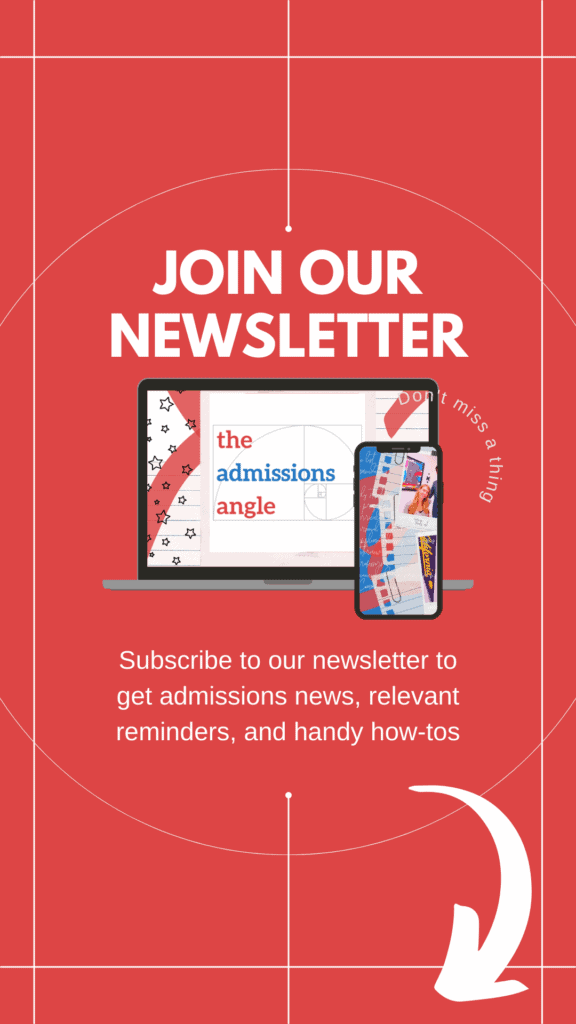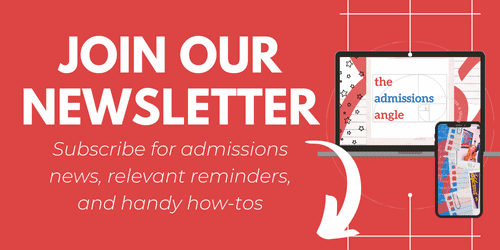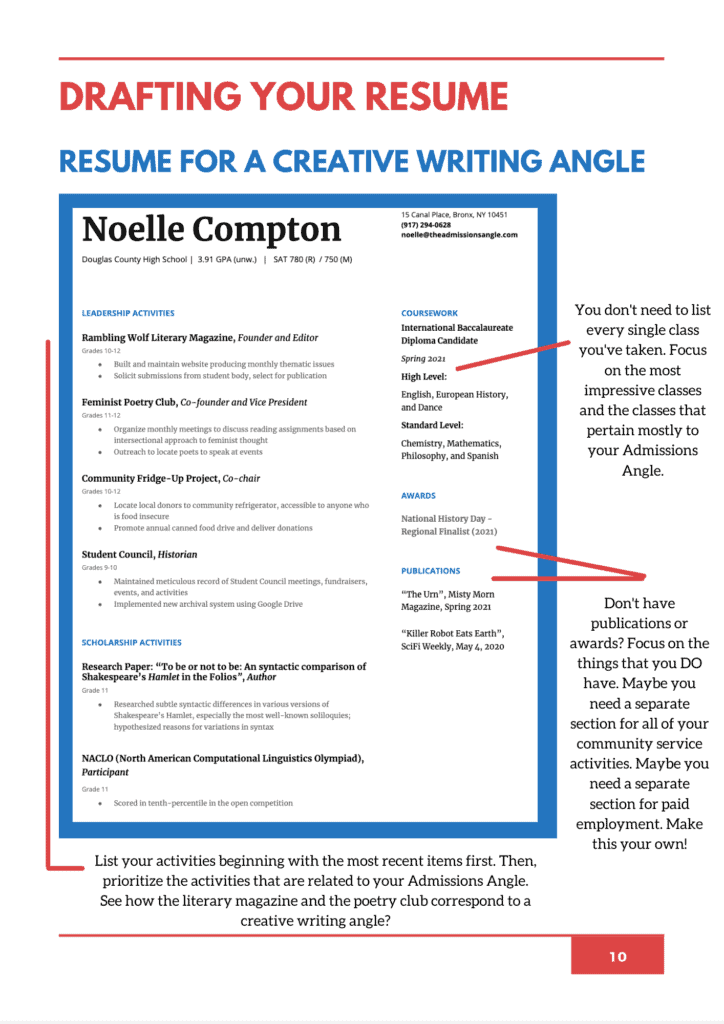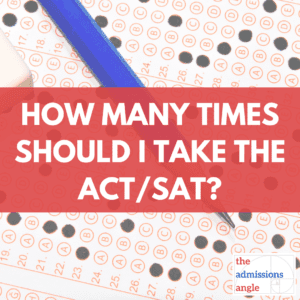
How to Write a Resume for
College Applications
Although not every college asks for a resume, having one ready to go is useful for a number of reasons. In this article, I will discuss the many uses for a great resume as well as how to write a resume for college applications.

By NOELLE COMPTON
Although resumes are commonplace for job and internship applications, you may also be asked to draft one at some point in the college application process. The good news is that once you have a resume you are satisfied with, you can edit it to serve each unique purpose as your experience and ambitions grow.
Why do I need a resume for college applications?
There are several reasons that you might need a resume when applying to colleges. First, and most obviously, the college might ask you for a resume as part of their application process. Oftentimes, this looks like an optional additional upload in the supplement section of the Common Application. However, for other schools such as Georgetown, the addition of a resume is strongly urged. Georgetown only offers space to discuss a handful of activities, so you will need the space on your resume to fully demonstrate what you’ve been involved in.
Second, toward the end of your junior year, you will need to ask your teachers for recommendation letters. Ideally, you ask for a recommendation from a teacher who knows you well, but even so, their experience with you is likely limited to the classroom. A resume can be helpful to a recommender because it contextualizes your personality, reminds them of your achievements, and gives them specific references to mention in the letter itself.
Third, a well-crafted resume is a good way to visualize your accomplishments if you need to reverse-engineer an Admissions Angle strategy. Alternatively, it can help you see what majors your profile is best aligned with.
And finally, a resume is an excellent thing to have on hand in case any excellent internship or employment opportunities come along. We have also had many cases wherein a college interviewer, coach, or representative may inquire about a resume, and in these events, it’s best not to keep important people waiting.
For these reasons and many more, we recommend having a base resume around at all times to use as the occasion calls for it.
What is the difference between a resume and a CV?
While these terms are occasionally used interchangeably, they are not the same. Here are a few of their distinguishing features for the nerds out there (like me). Alternatively, skip to the end of this section for the tldr:
Length
A resume is intended to be a page in length, two pages maximum. A CV, which is Latin for Curriculum Vitæ, meaning ‘course of life’ is just that — your whole life story. Depending on your career experience, this could span far more than just a page or two, and it will cover every job you’ve had, school you’ve attended, award you’ve received, etc. However, for college applications, a resume is what most schools are looking for.
Purpose
Both a resume and a CV are intended to demonstrate your skills, accomplishments, and history. However, a resume is geared toward something specific (like a particular job), and the goal is to spend your page showing all of the experience that is suitable for that specific thing. In this case, that ‘specific thing’ is your Admissions Angle strategy.
A CV is static, and you don’t change it depending on the purpose you need it for. Your CV is comprehensive and will include a complete record of every job or experience that you have ever have, giving a more holistic view of you as an applicant and as a person. In short, a CV is a list of your full history, while a resume is a targeted list of accomplishments.
Format
Both a resume and a CV are chronological, with your most recent experiences appearing at the top. A resume will include your highest level of education, but a CV will include a complete list of your educational achievements. In general, a CV tends to be styled more formally than a resume, and in fact, the European Union even has a CV template that you can use to make yours just right. A resume, on the other hand, is highly flexible in format, allowing you to choose the order in which to list your relevant experience.
TLDR;
You want a resume for college applications because you most likely don’t have enough achievements to fill a CV; Someday, you might, depending on your job sector.
What to include in your resume for college applications
Although each resume is different, there are some pieces of information that every recipient of your resume will want to see:
Personal Information
This includes your name, home address, email address, and phone number. These items generally appear at the top of the page.
Academic information:
This includes the name of your school, your GPA, and your SAT or ACT score. Although many resume templates include a separate ‘Education’ section, I find that it works best as part of your header, unless you can justify a full education section. For your GPA, do mention whether it is weighted or not, and if it’s not on the 4.0 scale, specify the scale that it is on. For your SAT or ACT score, you can choose whether the composite or the section scores make more sense to include based on how impressive they are and how much space you have.
Course information:
If you have or are planning to take any advanced courses, such as IB or AP courses, you can include a section on your resume where you list the courses and anticipated test dates.
Activities by category:
Depending upon your activities, achievements, and Admissions Angle strategy, you will want to list your extracurricular experiences differently. For this, a one-size-fits-all approach is impossible, but some categories that we generally find useful are scholastic, leadership, athletic, and service. Not all of these categories might apply to you, so be strategic in considering how to arrange your sections and activities. Within each section, you will want to put the most current activity on top then go backward in time from top to bottom. Most likely, some of your activities overlap in time, so put the most impressive and Admissions Angle activities toward the top.
Awards and recognition:
Any awards and recognition you’ve received deserve to be celebrated! You can put them in their own section if it makes sense to do so.
College Admissions Services
Schedule a Free Consultation
Meet with a mentor one-on-one via video chat to talk about your son/daughter’s admissions plan. Afterwards, receive a no-obligation Customized College Roadmap (CCR) with advice on courses, extracurricular activities, standardized tests, and Admissions Angle strategy.
How to format your resume for college applications
A well-organized resume is tremendously helpful, but difficult to format from scratch. While there are fancy, creative, and aesthetically exciting resume templates available for download online, I recommend that you keep it simple and prioritize ease of readability above all else.
Fortunately, MS Word and Google Docs both have plenty of pre-formatted templates that are easy to work with yet customizable for things like font and colors, so you can still make it your own. That said, all of the available templates are geared toward employment, rather than college admissions, so you’ll need to change things around significantly.
Here is a sample resume using the Google Docs “Serif” template that I’ve customized to support a creative writing Admissions Angle strategy.
General tips for your resume for college applications
Before you start building your resume, consider the following general tips to help you get started:
Start with a template on MS Word or Google Docs
Remember, function over form is important here. The easier your resume is to read, the better.
Customize the document to suit your unique profile
One size does NOT fit all. You might need to get creative here, but in any case, the goal is to celebrate your achievements and present your accomplishments in the most convincing way possible.
Cater your document to your Admissions Angle
Consider the story that your resume tells and break down your categories in a way that makes sense (i.e. Leadership Activities, Scholarship Activities, Athletics, Publications, etc.)
Use bullet lists in the descriptions and focus on deliverables
What did you accomplish? Keep in mind that the formatting of these templates does not naturally lend itself to bullet lists, so you’ll have to format them manually. This is simple, just write your list of descriptions, pressing “enter” after each item, and then highlight all items and press the bullet list button in the toolbar.
Only use details from high school
Do not use content from middle school or earlier. You won’t be able to mention anything that happened prior to high school on the Common App either.
Start with the most recent items and work backward
In order to give yourself maximum flexibility, I recommend using grade levels instead of dates for the activities you were involved in. So instead of saying Art Club, September 2021 to April 2023, I would say Grades 10, 11. This will allow you a little more leeway when it’s time to order your activities.
Use perfect grammar and consistent styling
Don’t be afraid to ask for help from a trusted adult or savvy friend.
Start simple
If you don’t know which activities to include, try starting with a list of all the things you have been involved in and narrow it down to the ten things you’ll include on your Common App.
It's up to you to sell your accomplishments
If you don’t believe in yourself, how can you expect the admissions officer to believe in you? Make it sound exciting. Don’t skimp on details. Don’t sell yourself short.
Happy resume crafting to you! Don’t be afraid to drop your comments and questions in the forum.













